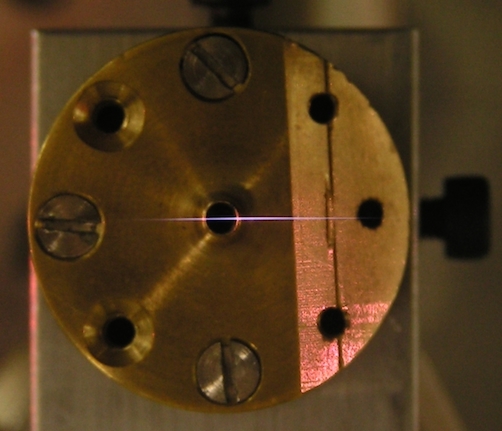Experimental chamber 3: Interaction with gaseous media
Experimental chamber 3: Interaction with gaseous media
The laser pulses are focussed by a parabolic mirror of long focal length leading to a relatively large focal point of about 40 µm. The intensity reaches a few times 1015 W/cm2. Gas is supplied in the focal area by several methods:
- a gas jet which exits from a pulsed valve;
- a gas cell, i.e. a gas-filled metallic tube. The laser drills small entrance and exit holes into this tube;
- background gas, i.e. the whole chamber is filled with gas of very low pressure.
Ionized gas in the laser focus: The gas jet exits from the opening in the center and is ionized in the region of the focussed laser pulse (bright horizontal line). (photo: D. Hemmers)
Our research deals with the intense light pulses' interaction with different gases. A main point is the coherent hard radiation that can be generated that way and which we employ in subsequent experiments in a separate diagnostics chamber. Our topics:
- Ionization dynamics of different gases: Gases are ionized by the enormous fields in the laser focus and also by the generated hard radiation. We analyse the generated ions (species, numbers) by a time-of-flight spectrometer. The ionized electrons are also investigated, yielding information on the light pulses' CEP (carrier envelope phase), for example.
- Generation of High Harmonics: The intense light pulse generates laser-like hard radiation in the gas down to wavelengths around 5 nm. This novel radiation is coherent and well-directed. It contains all odd multiples of the laser frequency and is emitted as a train of ultrashort light flashes with durations of only a few hundred attoseconds. We try to optimize this radiation to make it available for further applications.
- Coherent diagnostic techniques for hard radiation: We develop measurement techniques which employ the High Harmonic's coherence, for example methods involving diffraction, phase contrast or interferometry. This can yield the coherence length of hard radiation or the complex index of refraction in the XUV-range for different materials.
Interference image using the 35th harmonic of the laser pulse (wavelength: ~ 23 nm): The larger the path difference, the worse is the contrast. We can deduce that the coherence length is about 1,5 µm (from D. Hemmers und G. Pretzler., Appl. Phys. B 95, 667 (2009)).



